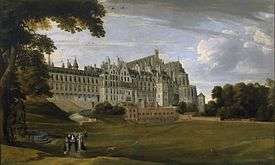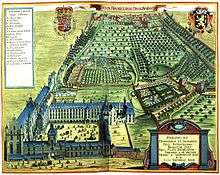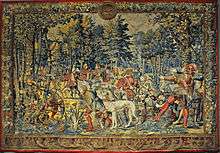Coudenberg

Coudenberg or Koudenberg (![]() listen ; Dutch for cold hill) is a small hill in Brussels where the Palace of Coudenberg was built. For nearly 700 years, the Castle and then the Palace of Coudenberg were the seat of government of the counts, dukes, archdukes, kings, emperors and governors who from the 11th century until its destruction in 1731, exerted their sovereignty over the area of the Duchy of Brabant, now in the southern Netherlands and northern Belgium. After several years of recent excavations, the archaeological vestiges of the palace and its foundations are open to the public.
listen ; Dutch for cold hill) is a small hill in Brussels where the Palace of Coudenberg was built. For nearly 700 years, the Castle and then the Palace of Coudenberg were the seat of government of the counts, dukes, archdukes, kings, emperors and governors who from the 11th century until its destruction in 1731, exerted their sovereignty over the area of the Duchy of Brabant, now in the southern Netherlands and northern Belgium. After several years of recent excavations, the archaeological vestiges of the palace and its foundations are open to the public.
History
In about 1100, the counts of Leuven and Brussels left the bottom of the valley of the Zenne and built their castle on the heights of Coudenberg from where they could dominate the small city. With the creation of the Duchy of Brabant in 1183 by the German Emperor Frederik Barbarossa, Coudenberg gained in importance and was included within the first great wall built around Brussels. The hunting park of the dukes led down the hill to the north, a remnant of which is now Brussels Park.

With the second enclosure of the city, following the 1356 occupation by Louis II of Flanders, the castle was no longer necessary as a primary defence, and it was gradually converted from a military strongpoint into a residential palace. After 1430 when Brabant was annexed by inheritance to Burgundy, Philip the Good built new wings for the palace, embellished the park, and built the Aula Magna, the gigantic room for royal receptions and other pageantry. The first regular meetings of the States-General, composed of delegates from the middle class, clergy and nobility of the Burgundian Netherlands, were held there in 1465.

It was in this room that in 1515 Margaret of Austria formally relinquished her regency over the Low Countries to Charles von Habsburg, and the future emperor Charles V became the Duke of Burgundy. It was in this same room that 40 years later Charles V abdicated in favour of his son, King Philip II of Spain. During his reign, Charles V created Bailles Square (Baliënplein or Place des Bailles) in front of the palace, built galleries and rooms in Renaissance style and constructed the Grand Chapel in late Gothic style in memory of his parents, Philip the Handsome and Joanna of Castile.
In the 17th century, under their reign as the sovereigns of the Spanish Netherlands, the Archdukes Albert and Isabella established their court on the Koudenberg. The archdukes restored the façade of the palace, transformed the buildings and refitted the apartments and gardens. For the protection of the Archduchess as she made her way to her devotions in the cathedral (this being the height of the Wars of Religion), the street which skirts the Aula Magna and the chapel was extended almost as far as the Cathedral of Saint-Michael-and-Gudula, and renamed Rue Isabelle (Isabelle Street). As art lovers, the archdukes brought to their court the best artists of the time, Jan Brueghel and Rubens among them, to decorate the palace with their works.
On the night of February 3, 1731, fire broke out in the kitchens and quickly engulfed the entire palace. The freezing conditions made it difficult to deliver any water and the means of firefighting were very insufficient. In the morning, the palace was in ruins with many of the works of art destroyed along with the governmental archives. Only the chapel was saved. The court moved elsewhere. Unfortunately money was not available for rebuilding, so for more than 40 years, the ruins of the palace remained. It was only in 1774 that Charles Alexander of Lorraine proposed replacing the ruins with a Royal Square. Because of the architectural clash between the Gothic chapel and the surrounding buildings, the chapel was pulled down.
Modern
Just off the southwest corner of Brussels Park, lies the Royal Square (Place Royale or Koningsplein) which was built atop the ruins of the old Palace. Originally a statue of Prince Charles Alexander of Lorraine, the then (1780) governor of Austrian Netherlands, by Peter Anton von Verschaffelt was placed in the square. The statue was not equestrian, but showed Charles-Alexander standing, attending to the affairs of government. Unfortunately, following the French Revolution and during the occupation of Brussels by the French, it was melted down for the value of the metal. The current equestrian statue is of a young Godfrey of Bouillon. A new statue of Charles-Alexander of Lorraine was eventually placed nearby in the Museum Square.
The Royal Square on the Coudenberg is faced by the church of St. Jacob-on-the-Coudenberg. It was built by two French architects, Montoyer and Guimard, in classic style from 1776 to 1780. In the 19th century the dome and two side wings were added.
There are a number of other buildings on Coudenberg including Belgium’s General Accounting/Auditing Office (Rekenhof or Cour des Comptes); the Royal Chapel, built in 1761 with a Louis XVI – style interior; the Palace of Lorraine; and the Royal Museums of Fine Arts of Belgium.
Archaeological remains and partial restoration
The remains of the ancient palace and adjacent building have been extensively excavated below present ground level, and preserved with a partial concrete cover. The remains can be visited via the Bellevue museum, and provide an excellent presentation of this historical artefact. The main buildings of the palace stood on roughly the same site as the present-day museum and the very wide street (Rue Royale/Koningstraat) which faces it. The adjacent Chapel and Aula Magna buildings stood on sites which are now respectively part of the Bozar centre and the north corner of Place Royale/Koningsplein beside the Musical Museum. The former Rue Isabelle/Isabellastraat ran beside these buildings; it had a significant slope, but the present surface of Rue Royale which parallels it is level, as the whole area was levelled in the 18th century. The lower rooms of these buildings partially survived the fire, and are exposed in the archaeological site.
The preserved remains presently visitable comprise:
- the cellars of the main palace
- the rooms underlying the main banqueting hall in the Aula Magna
- the warehouse space that underlay the chapel
On the other side of Rue Isabelle all along its length lay the house of the influential Counts of Hoogstraeten, currently (2008) at an advanced stage of excavation, with a view to later opening to visitors, alongside the existing remains.
- Archaeological remains and partial restoration
-

Stairs -

Passage -

Foundations -

Interpretive panel
References
- This article is based in part on material from the French Wikipedia.
- Under the Royal District An Other Palace..., undated catalogue to accompany the exposition.
External links
Coordinates: 50°50′33″N 4°21′36″E / 50.84263°N 4.36009°E
